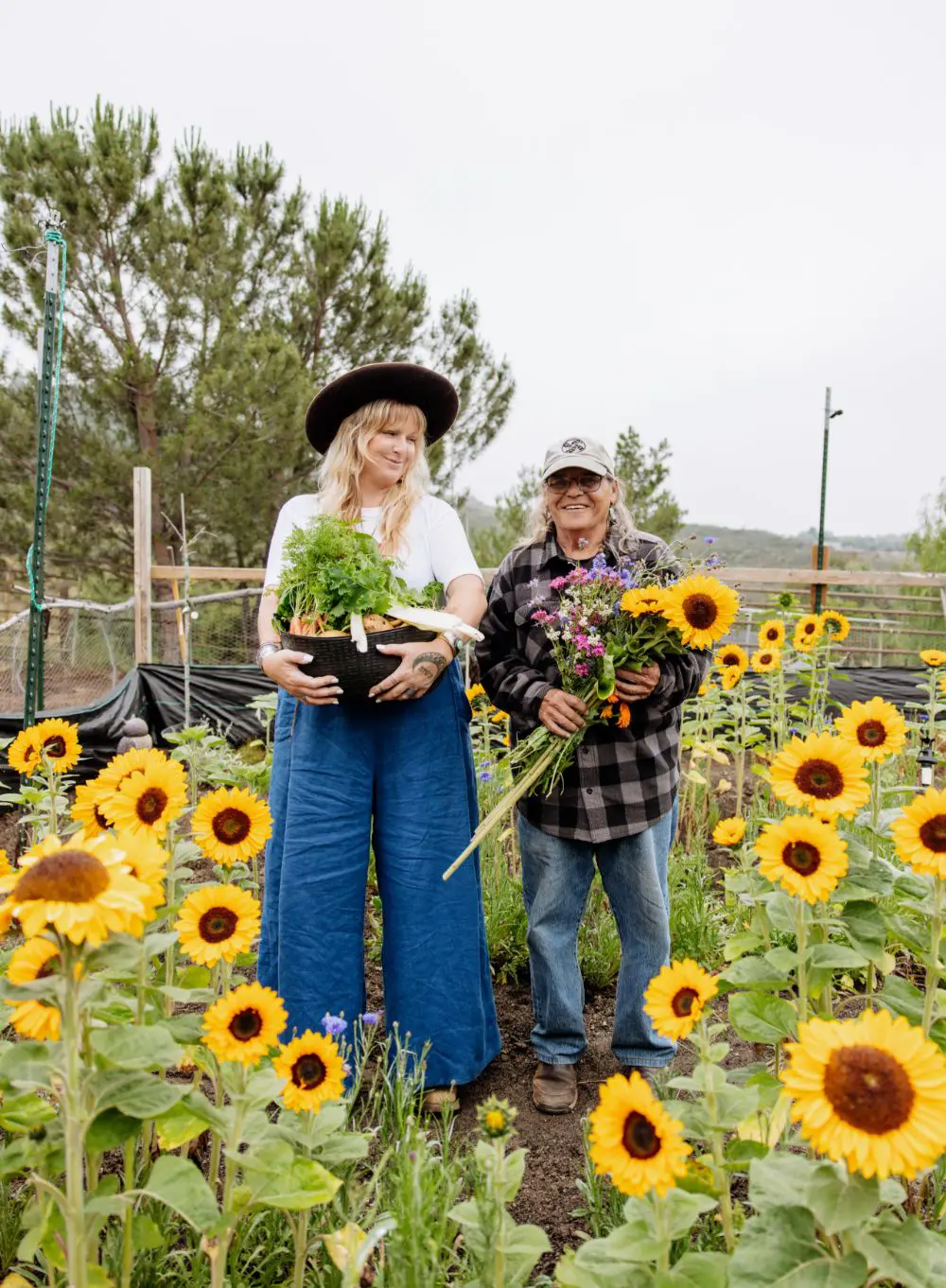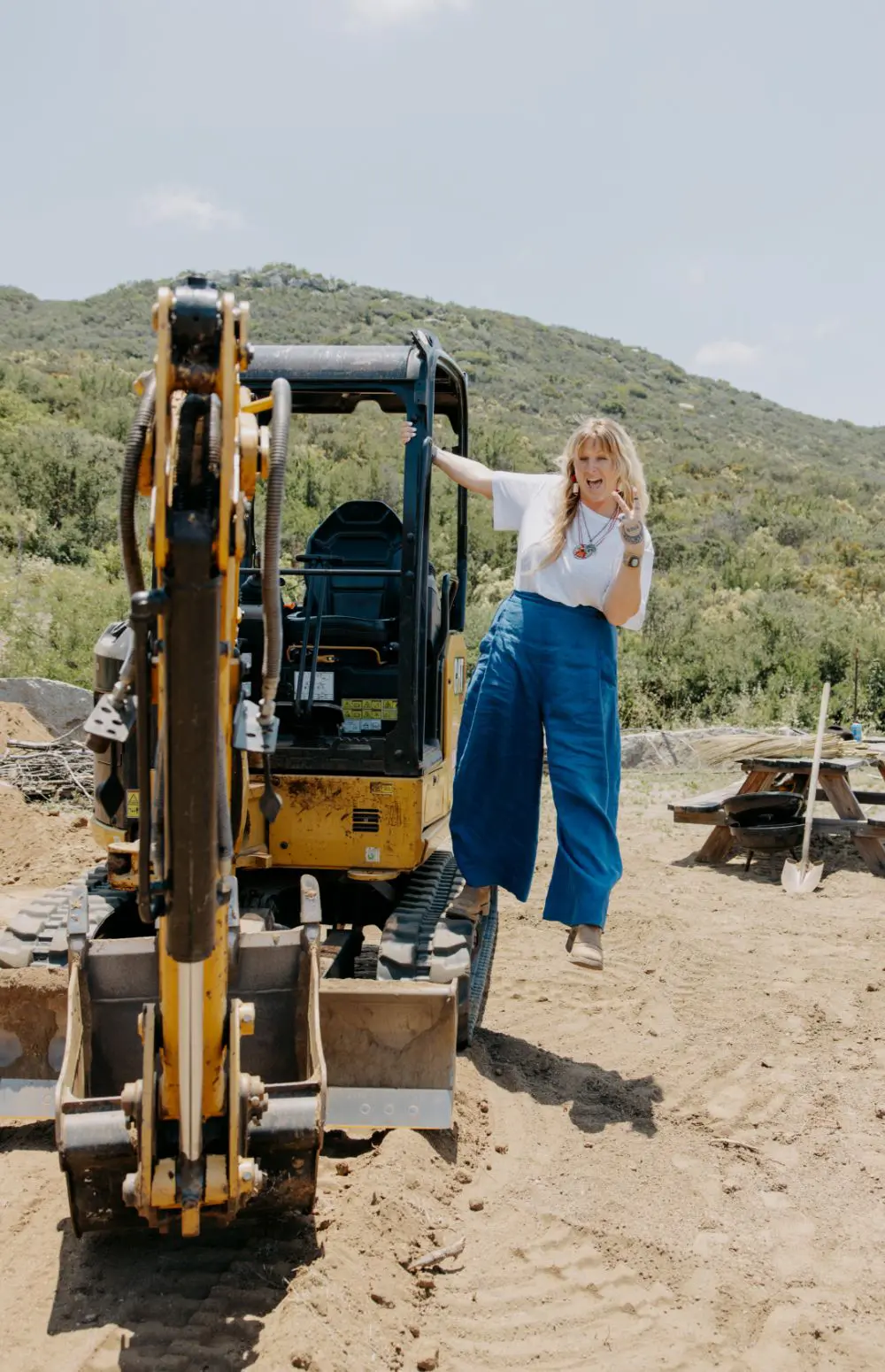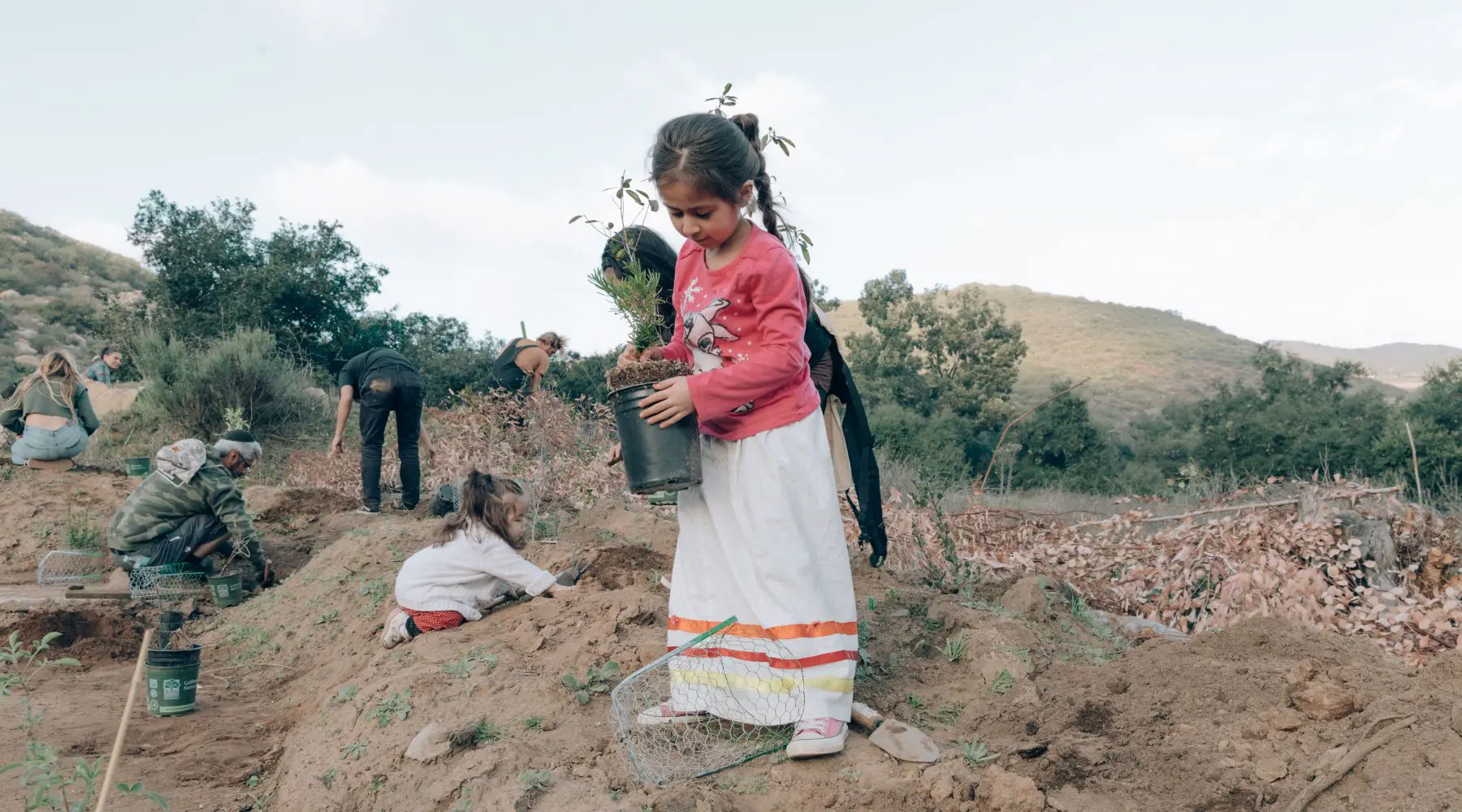Meet A Farmer
Indigenous
Regeneration
Valley Center, California
“When we live within the cycle of nature, health and wellness follow.”
– Lacey Rae Cannon
“If the soil is not healthy, our food is not healthy and subsequently our families will not be healthy.”
– Lacey Rae Cannon
With a history in organic farming and a desire to be outdoors with her children and meeting more of the community on the reservation, a vision for a community garden started as the focus. Leveraging her strong network of supportive musicians and friends accumulated over years in the music industry, she rallied her community to organize a benefit concert with the aim of raising essential funds to jumpstart the nonprofit organization’s launch.
What began as an idea for a humble community garden space soon evolved into a far-reaching mission spearheaded by esteemed community elders and dedicated tribal members. Through collaborative efforts and strategic partnerships, Indigenous Regeneration rapidly expanded to encompass three distinct project sites. These included the Mata’Yuum Farm & Garden, the San Pasqual Elders Medicine Path and Constructed Wetlands, and the Ishpa Kumeyaay Food Forest. Together, these initiatives spanned across 11 acres, serving as vital restoration projects and vibrant community food spaces.
Everything comes back to the soil
When we asked them more about the connection between human health and soil health, they shared how it’s all woven together into the tapestry of the ancient and traditional tribal value to honor and connect with the land, “We choose to live within the cycles that promote healthy soil because it directly reflects the health of our minds, bodies and souls. When we live within the cycle of nature, health and wellness follow”. – Lacey Cannon
The focus on soil health is how Lacey aligns their priorities. On any given day they are elbow deep in the soil and these core areas of focus:
• Traditional and contemporary food cultivation
• Environmental awareness and re-connection to the land
• Traditional plant education and integration
• Indigenous primitive survival skills
• Healthy self expression through music
• Art and cultural activities
• Regenerative agriculture concepts
• Sustainable building techniques
All of their programming is designed from an Indigenous view, overseen by elders and aligned with holistic practices for modern benefits.

– Lacey Rae Cannon


Lessons learned and wisdom found
“Our biggest struggle at Mata’Yuum was in our first cycle of growing food, we had a dry well. We are an off grid operation and so our solar panels will only power our well pump during the day. However, in 2018 it was such a dry year that the groundwater would drop too low for our well to pump when the solar was able to work for us. We definitely learned how to be water wise and save up days of water to spread between the gardens and medicinal plants to keep everything alive.”
“Our biggest lesson through it was to be prepared for anything!”
– Lacey Rae Cannon
Vision
IRG’s vision is to create an education center that teaches everything from regenerative agriculture to all earth building styles, food forestry, systems technology, husbandry and ethnobotany in order to heavily impact tribal communities and create a platform to help their community get off grid and to be more self-sustained.
To Lacey, sovereignty means tribes having control over their food, medicine and housing in a way that frees their communities from the colonized systems of the modern world and allows space for all to thrive while building a greater connection to the land and traditional ecological knowledge.


Where are
they now?
How has your understanding of regenerative agriculture shifted in the past 3 years?
Regenerative Agriculture is an interesting topic because there are many different definitions of what it is. As Indigenous Regeneration (IRG) has explored regenerative farming practices over the last 7 years we have experimented with different practices that would be under the umbrella of “regenerative” as in building healthy soils, using cover cropping, practicing plant rotations etc. We have also gone through stages of using market farming rows and then eliminating them only to find our food production went down. As our late elder Richard Bugbee came to claim, colonized plants indeed need colonized rows to thrive in. There is a place and home for rows, for food forests and for our native plants to all be combined into a balanced environment for each plant relative to thrive. My teacher ( Richard Bugbee) and I used to have long talks about agriculture and it being the demise of mankind because it brought about a need to own land and narrowed how we moved and lived in relationship with our relatives (the natural landscapes in San Diego.)
We would talk about water and how the shift in our original waterways and reserves and the introduction of dams changed California and the impacts of that especially on our tribes in California, Bishop is a great example of this. We can’t really call any farming in California regenerative to be honest if the water is coming from pipes. Its kinda funny I suppose to have a farm school and to be teaching “regenerative farming” when systematically, processes are so corrupted by colonized structures that have forced us into a place where the best we can do is to now modify our farming to be “less negatively impacting” to our landscapes vs, living in relationship with what’s naturally here.
I would now define regenerative agriculture as the practice of diving deeper into native food systems, recharging aquifers on the land you’re farming on, combining some row cropping with cultivation of native foods, fruit trees requiring low water use, and the farming of trading trail foods such as nopales which require no water. Quail are an excellent food to farm and breed in captivity as most people do not have the ability to hunt and gather these “traditional diet” birds anymore. Rabbits are also a fast breeding food source.
It’s important that we start looking at our bioregions and thinking about sustainability from this lens. A lot of that requires a shift in our taste buds. There is a lot of exploration left in what regenerative agriculture and food cultivation could look like in San Diego. We are exploring that at Paradise Tribal Farm.
What new evolutions have surfaced on your farm since your feature? Please share the victories, challenges, and all the updates!
We have had many changes since our feature, one main one being that our feature was precovid. Since that time IRG turned our first teaching hub and garden “Mata’Yuum” back to The San Pasqual Tribe along with 28 acres of native food and medicine projects and we started Paradise Tribal Farm. We now hold a 25 year lease on 6 acres of land that is budded up to the base of Paradise Mountain and Rodriguez Mountain in Valley Center just 10 minutes from the San Pasqual Reservation and 30 minutes from our sister tribes near Pauma Valley. This shift has allowed us to provide a wider range of programming to multiple tribes in San Diego bypassing the challenges of tribal politics. This shift has allowed us to commit long term with our funders and partners to create an educational hub that will be able to grow for many decades. This has led to partnerships with Climate Science Alliance and their Tribal working group, Sacred Places Institute, Indian Health Council and a variety of tribal education departments. Additionally Paradise will now be the practical application location for Ethnobotany and Ethnoecology classes at Kumeyaay Community College. Thanks to funding through The San Diego Foundation, we are building our processing center/kitchen classroom that will become the hub for native food processing for tribal community members and a distribution hub for a plant prescription program being launched with our partners at Indian Health Council.
In response to the changes brought about by the COVID-19 pandemic, Indigenous Regeneration has introduced Indigenous Regeneration TV, set to debut in 2024. This platform will feature educational content led by the late Richard Bugbee and his apprentice, Lacey Cannon. The pandemic underscored the importance of documenting our elders, digitizing content, and expanding our outreach through technology. As a result, our in-person classes and workshops will now be accessible online to a wider audience, ensuring that valuable knowledge and teachings are available to anyone, regardless of location or circumstance.
Paradise Tribal Farm has been and will remain dedicated to training tribal farm apprentices who play a crucial role in our efforts to cultivate food for distribution in free farm boxes. Initially available only at the San Pasqual Reservation, this initiative is expanding to include the Indian Health Council’s Clinic in Rincon by 2024, as part of their diabetes prevention program. Our goal is for these apprentices to depart Paradise equipped with a strong foundation of knowledge and a viable business plan. We hope they will return to their respective reservations, empowered to initiate their own tribal food sovereignty projects, with the aim of implementing similar initiatives on every reservation in San Diego within the next 5-10 years.
What is your perspective on what is needed to achieve food sovereignty for your community?
Speaking on behalf of every tribe isn’t something I’m comfortable with. However, what I’ve shared reflects issues affecting all Tribal communities: water, land, education, funding, and opportunity. Our Tribes possess rich generational knowledge, and we’re stepping into spaces of empowerment and self-governance. External communities are starting to recognize and respect our wisdom, supporting our desire for opportunities to thrive and grow. Funding and support are crucial for honoring our traditions and enacting systemic change within Tribal communities. Ultimately, self-governance is our ultimate aim.
What brings you hope?
Witnessing the youth connect with the land fills me with hope. One of the most beautiful aspects of this work is hearing their ideas. Watching children derive joy from the garden, interacting with the goats, or simply being free is immensely rewarding. Running Indigenous Regeneration, seeing this innocence untouched by cynicism is refreshing. I cherish listening to their visions for a brighter future and the dreams they hold. The youth’s natural resilience inspires me daily, reminding us all of the importance of cultivating a healthier relationship with our environment and its inhabitants. Hopefully, our efforts will pave the way for a future where their work as elders is lighter, and the generations to come find it easier to carry on the legacy of stewardship.
What support do you need/ how can our community support you?
We greatly appreciate any financial assistance as we’re facing increased expenses due to inflation and rising construction material costs for expanding our teaching center building at Paradise Tribal Farm. Additionally, we gladly accept donations for stipends for tribal farm apprenticeships, which support tribal members as they learn about cultivating food and native plants. These stipends help compensate them for their time dedicated to learning.
We are currently seeking assistance with editing numerous hours of footage featuring the late elder Richard Bugbee. This invaluable footage holds profound educational insights that we wish to share with our community and beyond. Editing this content is a meticulous task, requiring attention to detail to ensure clarity and coherence. Additionally, we are in need of support with uploading this edited material to our newly established educational online platform. By collaborating on this endeavor, we aim to preserve the wisdom and teachings of Richard Bugbee while making them accessible to a wider audience, thus perpetuating his legacy of knowledge and inspiration.
Additionally, as we prepare to release our Kumeyaay Ethnobotany board game this spring, created by the esteemed late elder Richard Bugbee and his apprentice Lacey Cannon, the founder of Indigenous Regeneration, this game is a labor of love aimed at celebrating and preserving indigenous knowledge of San Diego plant life. Through engaging gameplay, players will embark on a journey of learning and discovery, exploring the rich cultural heritage of the Kumeyaay people and San Diego’s bio regions. To pre order your copy and be part of this meaningful endeavor, please visit indigenousregeneration.org. Thank you for your unwavering support!




